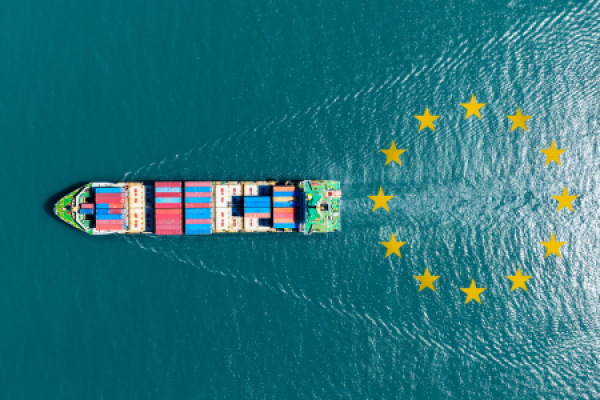
Hill Dickinson
Published: March 10, 2025
The FuelEU Maritime Regulation (Regulation (EU) 2023/1805) (“the Regulations”) is the most recent addition to the European Union’s “Green Shipping” package.
The Regulations work alongside the EU ETS and MRV Regulations to decarbonise maritime transportation. The Regulations have been introduced as part of the European Union’s endeavour to achieve a 55% reduction in greenhouse gas (GHG) emissions by 2030 and to encourage the sector to switch to renewable and sustainable fuels.
In order to achieve this, the Regulations provide GHG intensity targets that vessels within its scope must adhere to in respect of the energy used on board. Essentially, vessels must continually record their energy usage (regardless of whether they are at berth or sea), report annually and verify this data and not exceed the applicable limit for that time period. Vessels are expected to reduce their yearly GHG intensity by 2% in 2025 with this percentage increasing every 5 years until 2050.
In order to determine the GHG intensity of a vessel, the Regulations provide methodology at Annex 1 taking into consideration the amount of GHG emissions per unit of energy. It is key that companies use the same monitoring methodology and data sets each year so that the data is comparable. It is equally as important that this data is recorded on the specifically designed FuelEU database alongside being stored and retained for 5 years.
Due to the type of fuel used, engine systems and methane slip, only certain vessels will be compliant from the start. It is likely that VLSFO and MGO vessels will immediately be at risk of non-compliance due to their GHG intensity. Over time, more and more vessels will become non-compliant due to the increasingly stringent targets. It is therefore crucial for those responsible for the ship’s compliance, to fully understand the Regulations, what they need to do to make their vessel compliant and if necessary, how they can attempt to avoid the penalties.
The new regulation applies to all ships over 5,000 gross tonnage that either carry passengers or cargo for commercial purposes. For Intra-EU voyages where the arrival and departure port are both Member State (MS) ports, the regulation applies to 100% of the energy used. Whereas for voyages where the arrival or departure port is located in an outermost region under jurisdiction of a MS, or for voyages between a MS and a third country, the regulation only applies to 50% of the energy.
Scope
The emissions that fall within scope are CO2, Methane and Nitrous Oxide. However, for ease, all emissions are converted into CO2 equivalent. Unlike the EU ETS which only focuses on CO2 emissions from tank to wake, FuelEU takes into consideration the full lifecycle of the fuel, covering well to wake. Well to wake includes extraction, production, supply of the fuel to ship’s tanks and combustion. Accordingly, more thought needs to be given to the broader impact of the fuel used.
When calculating a vessels’ GHG Intensity, the well to tank phase and the tank to wake phase are considered separately. While calculating the well to tank emissions, companies are forced to use the default values provided in Annex II of the FuelEU Regulations (a separate formula is provided for Biofuels and RFNBOs). In comparison, when calculating the tank to wake aspect of the GHG intensity (i.e. the combustion of the fuel), companies are able to depart from the default values found in Annex II provided they are able to either get the actual values certified by lab testing or direct emissions testing.
Companies are strongly encouraged to make the move to Renewable Fuels of Non-Biological Origin. These are synthetic fuels that are produced by way of renewable energy or carbon capture and are therefore much more sustainable and environmentally friendly. In order to incentivise this move, the Regulations stipulate that the energy from RFNBOs counts twice towards a vessel’s GHG intensity. If there is not a convincing uptake whereby at least 1% of fuel used by ships is RFNBOs by 2031, there will be a minimum use annual subtarget of 2% for all vessels from 2034 onwards.
Biofuels on the other hand, can assist with reducing GHG intensity but due to their biological origins, are not as sustainable and each pose their own environmental issues as a result of their production and combustion. For example, an ethanol-gasoline mix may ultimately produce lower GHG emissions. However, due to it having higher evaporative emissions, can in fact increase smog.
Further, although a biofuel is less likely to require an expensive retrofit, there are a wide variety of feedstocks used to create and develop new biofuels which have not yet been tested in marine engines. There is therefore a high risk of possible claims arising in the future as a result of incompatible biofuels being burnt in vessel engines.
Who is responsible
The Regulations provide that it is the document of compliance (“DoC”) holder that is responsible for ensuring a vessel’s compliance with the Regulations. Given that the DoC holder is likely to be the owner or manager of the vessel, this aspect of the Regulations evidently raises concerns and is a gateway to potential future disputes.
A vessel manager has limited control over the operational decisions of the vessel. A similar situation arises under a time charter, where the charterer will decide where the vessel trades as well as being responsible for bunkering, navigation and operational decisions relating to the vessel. Essentially, the charterer will control whether or not the vessel is compliant. Despite this, it will be the Owner or external manager who are the party that have to bear the risk of the non-compliance penalty.
The Regulations themselves do not provide assistance with passing the burden of the fines/penalties to the actual polluter.
Compliance
If a vessel’s emissions fall within the intensity target limit, they will be in a surplus and therefore compliant.
Those vessels that have positive emissions, will receive a DoC by 30 June of the verification period after each reporting period. All ships trading within the EU and the European Economic Area (“EEA”) will need a DoC that confirms their compliance with the reduction targets and overall regulations.
If a vessel is in a compliance surplus, they may choose “Banking” as a means of storing this excess by rolling it over to use for the next reporting period. This will be beneficial for those vessels that are compliant to start with but risk not being able to meet the later more stringent reduction rates. Notably, any intention to carry over surplus must be approved by the verifier in advance.
Non-Compliance
On the other hand, if a vessel’s emissions exceed the target set by the FuelEU Regulations, the DoC holder will receive a penalty. The amount of the penalty will be calculated using the formula laid out in the Regulations taking into consideration the difference between the required and achieved GHG intensity and based upon EUR 2,400 per tonne of VLSFO equivalent.
Essentially, the higher the GHG emissions, the higher the penalty.
Once a penalty has been paid, the vessel will then be considered compliant and will therefore receive a DoC that they can then use to demonstrate their compliance when trading within the EU and EEA over the forthcoming reporting period.
If a vessel is non-compliant for two consecutive years, they are considered a repeat offender and will therefore receive a harsher penalty. The penalty will increase by 10% every consecutive reporting period until the vessel obtains a surplus that resets the increase factor. An offending vessel that enters a Member State port will be at risk of detention if they are flying that Member State’s flag, as it is the Member States that are responsible for enforcement. Alternatively, they will be at risk of an expulsion order if they are flying a different flag.
Avoiding Penalties
As well as Banking, discussed above, there are other options open to the DoC holder to avoid penalties under the Regulations.
Borrowing – Article 20
In order to avoid the penalties and minimise financial exposure, a vessel in a deficit may choose to borrow an advance surplus from their allowance in the next reporting period. While this may prima facie seem like an easy decision, it does in itself contain a penalty in that interest is charged on the borrowing. The borrowed amount will be multiplied by 1.1 before it is subtracted from the next reporting period balance. Further, there is a restriction on the amount that can be borrowed, being 2% of the compliance surplus and a vessel is not entitled to borrow for more than two consecutive years.
Pooling – Article 21
Pooling of GHG intensity is a second option; pooling adds a bit more flexibility, as a vessel in a compliance deficit may choose to pool with other vessels so that the overall compliance balance average of the emissions of the vessels in the pool is compliant. Essentially, the overperforming vessels offset the underperforming vessels.
The pooled vessels do not need to be owned by the same company. However, the conditions are that the fleet as a whole must be in a surplus and a vessel cannot be entered into more than one pool in a reporting period (other than for sub-pooling for the RFNBO subtarget).
When deciding whether or not they wish to pool their vessel, owners/managers should consider the cost/benefit of deficient and surplus vessels. Regard must also be given to whether the vessel has chosen to bank or pool their surplus/deficit. A vessel that has made use of the borrowing provision, is unable to be entered into a pool for that reporting year. However, a pooled vessel in a surplus may still opt to bank some of their compliance surplus so long as the overall pool will also remain in a surplus.
A company must notify the verifier of its intention to include a ship’s balance sheet in a pool by April of the verification period after the reporting period. Following which, they must then register this intention with the FuelEU database and stipulate the allocation of the total pool compliance.
An issue which we expect to see arise from pooling is what is to be done if a vessel does not achieve its anticipated emissions level resulting in the whole pool’s performance becoming compliance deficient. As such, there is the evident need for cautiously drafted pooling arrangements.
Key Takeaways
The new FuelEU Regulations are complicated and Members will need to familiarise themselves with the substance of the Regulations and to plan for how to deal with them both in practical terms but also in how the Regulations impact on contracts, particularly management and charterparty agreements.



